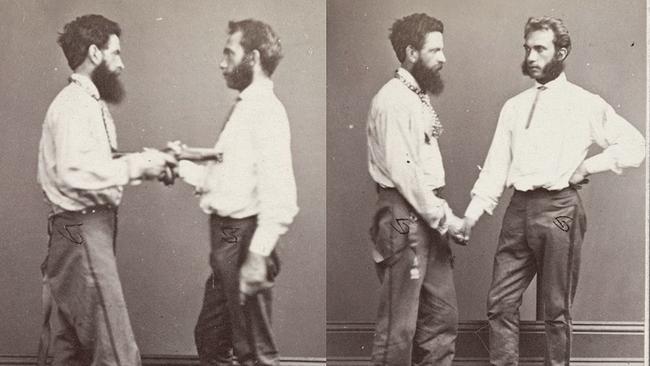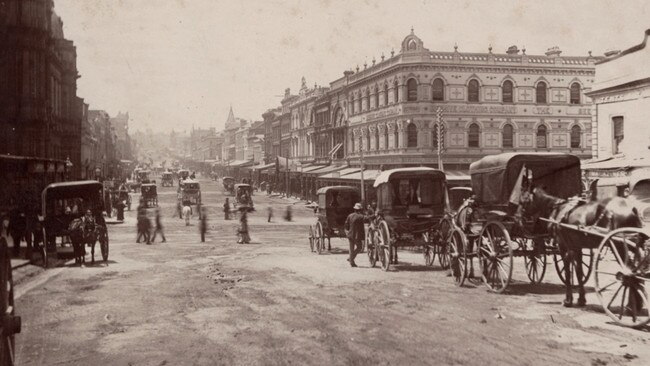Treasury Gardens shooting one of Melbourne’s strangest crimes
Two men walked into a Melbourne photography studio one afternoon in 1872 to pose with their pistols in a bizarre series of pictures. Hours later a gunshot rang out in nearby Treasury Gardens and their true intentions became clear.

Melbourne
Don't miss out on the headlines from Melbourne . Followed categories will be added to My News.
One Monday afternoon in March 1872, two men walked into William Davies’ photography studio on Bourke St and asked to have their pictures taken.
The strange pair didn’t seem entirely sober, and the poses they wanted were a little unusual.
They had brought with them two pistols, and wanted to hold them in the pictures.
One man, called Edward, was downcast and moody.
The other, Charles, was upbeat and seemed to have control.
He told Edward what to do, and Edward did it.
The pair larked with the guns, posing like bushrangers, before telling Davies’ assistant James Stewart to take a picture of them pointing the guns at each other.
Stewart told them they needed to stand close together if they wanted to fit in the same picture.
Oh yes. Close together. That was what the men wanted.
So close, in fact, that the barrel tips of the pistols would be pressed each against the other man’s chest.

In another photo, Charles said they should clasp palms, a pose that looked half like a handshake and half like lovers holding hands.
Edward didn’t like the idea but Charles insisted.
Charles also insisted he should have some photos taken on his own.
The playfulness was unnerving and at one point a pistol was aimed at Stewart’s head and the trigger pulled – but it wasn’t loaded.
Some copies of the pictures were ordered by the men, who then left.
The perplexed Davies and Stewart had no idea where the odd customers were headed.
Soon enough it became clear. About 4pm that afternoon a gunshot rang out in nearby Treasury Gardens.
It seemed Edward and Charles had pressed the pistols – loaded this time – against each other’s chests.
Charles had been shot dead. But Edward was still alive.
What followed was a murder trial for Edward Feeney, the surviving member of a duo who, according to the defence, had made a pact to die together.
But questions lingered about wether the shooting was more cold blooded than Feeney claimed.
DEATH IN THE GARDEN
Police, piecing together the movements of the pair before the shooting, uncovered disturbing details about the friendship between Edward Feeney and Charles Marks.
A man staying at the Great Britain Hotel on Flinders St said the pair had shared a room the night before the shooting and had been heard talking about their plot to kill each other.
It was believed the friends, who had met while working on hospital wards, had repeatedly fallen in love with the same women and the sorrow it had caused was enough to end it all.
On the day the plot was meant to unfold, after going to Davies’ to get their photos taken, the friends had gone to a wine shop on Bourke St where they spent time writing letters.

Marks wrote to his mother, telling her he was now in eternity, and that he and his friend died together.
The owner of the wine bar later told court that a pistol was loaded by the men at the table and had to be confiscated.
After drinking wine the pair went to the park and lay beneath a tree, and when the gunshot was heard, gardeners rushed to the scene.
The men were found lying on their backs, about six feet apart, beneath the low branch.
Marks had been shot through the heart and was dead.
The pistol that fired had also exploded, sending splinters of wood flying.
Feeney had a cigar between his lips when the gardeners approached.
The second pistol, loaded, cocked, lying between the pair, was never fired.
LETTERS OF ADORATION
The police investigation uncovered more unnerving details of Marks’ infatuation with Feeney.
Marks had been writing emotional letters, alluding to their regrettable pursuit of the same women, begging Feeney for them to become closer friends.
The sort of friends who would never be parted, who would go into business together and who would love each other like brothers, indeed, maybe more than brothers.
It was a proposition that had vexed Marks for some time, and raised questions about the reasons for his going after the same women as Feeney.
Maybe he wanted to thwart Feeney’s romances so he could keep him all to himself.
Feeney had responded with a noncommittal assurance that, while he was very fond of Marks, he was unsure such an arrangement could work.
He left Melbourne, saying that fate had decreed it.
But after a few weeks, something drew the pair together again and they formed the macabre shooting plot.

MURDER
A case was built against Feeney, who was charged with murder.
Prosecutors claimed Marks had an inexplicable control over him, that Feeney didn’t truly want to die in the pact, but instead intended to use it to get Marks out of the way.
It was claimed that Marks could not have possibly shot himself.
At the scene Feeney had claimed Marks had simply committed suicide but later his story became blurry.
Defence lawyers were hampered by the lack of a sensible account from Feeney, who was reluctant to divulge exactly what had happened.
The weird photos taken at Davies’ studio just hours before the shooting pointed to a suicide pact.
But even if that had been the case, the law still required the survivor to be tried for murder.
In a decision that shocked the colony, Feeney was found guilty after 20 minutes of jury deliberation, and sentenced to hang.
It was enough for The Argus newspaper to editorialise against the judge, Justice Williams, for his cruel remarks to Feeney, suggesting that he was a coward for not taking his own life after discovering that Marks was dead.
Edward Feeney was hanged on May 14, 1872, aged 38, at the Melbourne Gaol.
He was calm and collected all the way to the noose.
MORE MELBOURNE HISTORY
THE RISE AND FALL OF SOUTHERN CROSS HOTEL
THE GOLDFIELDS’ MOST SHOCKING CRIME
THE SAD TALE OF BRIGHTON MANSION
The public’s grim fascination with the case continued as Feeney’s death mask was displayed at a local wax works, with rumours that the proprietor had managed to get Feeney’s actual hair and beard for the wax head.
A letter from Feeney to his mother in Ireland was entrusted to a doctor shortly before his death, and the doctor guarded it from being read by anyone in Australia.
Questions remained over whether the shooting was a tragic pact gone wrong, or a premeditated killing.
The doctor, who had observed Feeney closely in his final days and was present at his execution, had formed his own opinion: it was murder.
